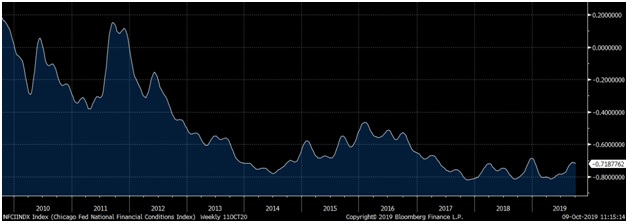The U.S.
The U.S. earnings season will shortly be getting underway. We suspect that as usual, companies have telegraphed enough realism to get analysts’ estimates into reachable or beatable territory. Of course, Mr Market will not just be watching EPS numbers, but looking at margins and watching for forward guidance — as well as getting a sense of the extent to which the U.S. is continuing to buck lower-trending global data.
Our view is that despite weakening sentiment data, the hard data for the U.S. continue to suggest that a bottom is near, or already in, in the mini-slowdown we’ve been experiencing since late 2018. Given that, we view this slowdown as similar to those of 2011–2012 and 2015–2016. While those periods were frustrating for markets, they were not signs of an imminent end to the expansion, and when the data improved, earnings improved, and markets resumed their rally. In spite of the emphasis placed by media on negative events and risks, we continue to see potential developments that could galvanize markets, especially in the U.S., for another leg higher. Some of these, such as substantive progress in U.S./China trade negotiations, could arrive unexpectedly and wrongfoot pessimists.
Critically, as we constantly observe, the current expansion is a credit-driven cycle, and credit conditions in the U.S. show few signs of deterioration. The Chicago Fed national financial conditions index, shown below, has ticked up, but remains firmly in negative (stress-free) territory, well below the stress levels of the last period of economic deceleration, and nowhere near conditions of 2012, when the European sovereign debt crisis was underway.
The Chicago Fed National Financial Conditions Index

Source: Bloomberg, LLP
The two- and ten-year Treasury yield curve inverted in August, but historically, that has been a sign that a market has significant appreciation ahead before its pre-recession peak. Our favored indicators do not yet signal that peak is imminent. Therefore we remain constructive on U.S. stocks.
Europe and Brexit
The recent call between UK Prime Minister Boris Johnson and German Chancellor Angela Merkel showed a bit more clearly that the EU has been bent on using the complex issues surrounding Northern Ireland simply as a tool to thwart the process of the UK’s exit from the EU. We are becoming more bullish on UK stocks and the British pound in the event of Brexit-related volatility.
Gold
Our medium and longer-term view on gold remains unchanged. Central banks, hedge funds, and individual investors are accumulating gold. As recently reported by the World Gold Council, gold-backed ETF holdings have hit record highs. Although the current expansion remains intact and we anticipate further appreciation for stocks, many institutional and individual investors are following Ray Dalio’s lead (as expressed in this post earlier this year) and adding to gold positions in anticipation of economic and financial shifts in coming years. We believe investors would be wise to begin giving strategic thought to their gold allocation.
Thanks for listening; we welcome your calls and questions.







